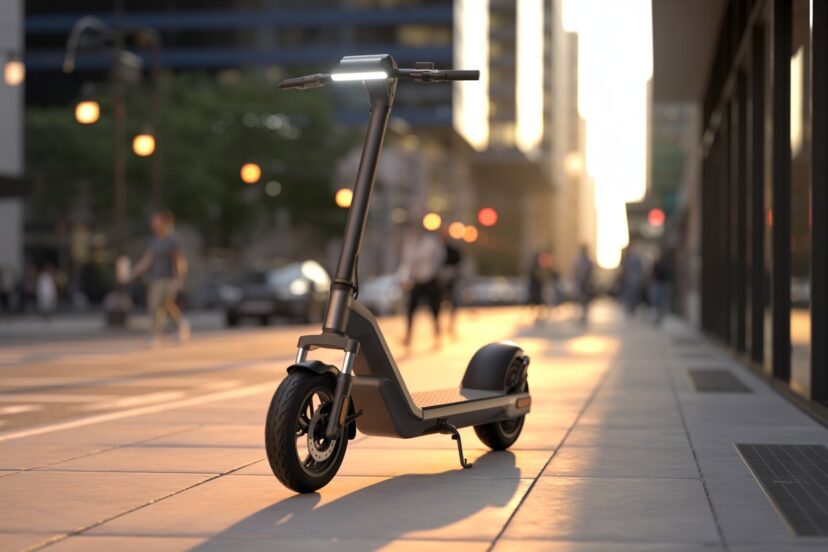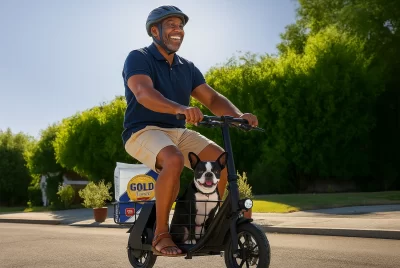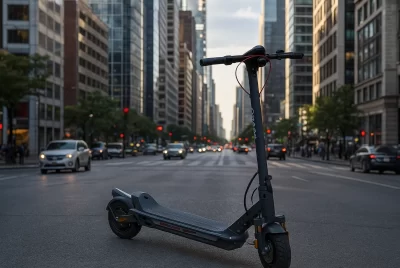Rent or Buy Electric Scooter: Making the Right Choice
*We may earn a commission for purchases made using our links. Please see our disclosure to learn more.
The morning commute stretched ahead like an endless maze of traffic lights and exhaust fumes. For countless urban dwellers, this daily ritual of frustration had become unbearable. Then came the electric scooter revolution—a sleek, efficient alternative that promised freedom from gridlock. But the question that stops many people in their tracks isn’t whether to ride an electric scooter, but whether to rent or buy one.
Standing at the crossroads of this decision, riders everywhere face a dilemma that goes beyond simple mathematics. It’s about lifestyle, commitment, and understanding what truly serves their needs. The choice between renting and buying an electric scooter represents more than a financial transaction—it’s a decision that shapes daily routines, influences environmental impact, and determines the quality of urban mobility for months or years to come.
“The shift to micro-mobility isn’t just about transportation efficiency—it’s about reclaiming time, reducing stress, and reimagining how we interact with our urban environments. The decision to rent or buy becomes the first step in that transformation.”
— Urban Mobility Research Institute
Key Takeaways
- Cost Analysis: Renting costs $1-3 per ride plus per-minute charges, while buying requires $300-$3000 upfront but offers unlimited use
- Usage Frequency: Daily riders save money by owning; occasional users benefit from rental flexibility
- Maintenance Factor: Rentals require zero maintenance effort; ownership demands regular upkeep and repairs
- Customization: Owned scooters can be personalized; rentals offer standardized experiences
- Long-term Value: Break-even point typically occurs at 3-6 months of regular use when comparing rental to ownership costs
Understanding the Electric Scooter Landscape
The electric scooter market has exploded in recent years, transforming urban transportation across the globe. Cities from San Francisco to Singapore now feature fleets of rentable scooters dotting street corners, while e-commerce platforms overflow with models available for purchase. This abundance of options, while exciting, can overwhelm those trying to make an informed choice.
Electric scooters have evolved from novelty items to serious transportation tools. Modern models boast impressive ranges of 15-40 miles on a single charge, speeds reaching 15-30 mph, and sophisticated features like regenerative braking, smartphone connectivity, and built-in GPS. Understanding this landscape helps frame the rent-versus-buy decision in realistic terms.
The Emotional Journey Into Electric Scooter Adoption
For many riders, the journey begins with a single rental experience—a moment of exhilaration as they glide past stalled traffic, feeling the wind and freedom that comes with efficient mobility. That first ride often sparks something deeper: a realization that there’s a better way to move through the city.
The transition from curious observer to committed rider rarely happens overnight. It unfolds through repeated experiences, each ride building confidence and revealing both the possibilities and limitations of scooter transportation. Some discover electric scooters during a car-free challenge, others when their usual commute becomes unbearable, and many simply out of curiosity when they spot these devices proliferating around their neighborhood.
The Rental Reality: Flexibility at a Premium
Renting electric scooters offers immediate gratification without long-term commitment. Users can access scooters through smartphone apps, unlock them with a tap, and leave them at their destination. This convenience comes with distinct advantages and limitations that every potential rider should understand.
The Financial Mathematics of Renting
Rental pricing typically follows a straightforward structure: an unlock fee of $1-3, plus per-minute charges ranging from $0.15 to $0.45. A typical 20-minute commute might cost $4-12 per trip. For someone making this journey twice daily, five days a week, monthly expenses quickly climb to $160-480.
These costs accumulate quietly. What feels like a few dollars per ride transforms into substantial monthly expenditures. Yet for occasional users—those who ride a few times per month—rental pricing makes perfect sense. The flexibility to use scooters only when needed, without maintenance responsibilities or storage concerns, justifies the per-ride premium.
The Convenience Factor
Rentals eliminate the entire ecosystem of ownership responsibilities. No charging cables cluttering the apartment, no worrying about weather-damaged components, no anxiety about theft while the scooter sits parked. When the ride ends, users simply leave the scooter and walk away.
This convenience extends to variety and availability. Rental fleets often include different scooter models, allowing users to experience various performance levels. When one scooter has issues, another sits just around the corner. This redundancy provides peace of mind that ownership cannot match.
Hidden Challenges of the Rental Model
The rental experience isn’t without frustrations. Scooters might not be available exactly when and where needed. Service zones restrict where riders can start and end trips, potentially adding walking distance to commutes. Battery levels vary unpredictably—nothing dampens enthusiasm like unlocking a scooter only to discover it’s nearly dead.
Weather presents another complication. Rental companies often disable scooters during rain or extreme conditions, leaving riders stranded without backup transportation. This unreliability can transform what seems like a dependable commute solution into an occasionally frustrating gamble.
The Ownership Experience: Investment in Independence
Purchasing an electric scooter represents a different philosophy entirely. It’s a declaration of commitment to this mode of transportation, an investment in reliable, personalized mobility. The ownership journey brings both empowerment and responsibility.
Breaking Down Ownership Costs
Electric scooter prices span an enormous range. Budget models start around $300-500, offering basic functionality adequate for short, occasional trips. Mid-range options in the $500-1200 bracket provide better build quality, longer range, and improved reliability. Premium models can exceed $2000-3000, delivering performance, durability, and features that rival motorcycles.
Beyond the purchase price, owners must budget for accessories and maintenance. Essential items include a quality lock ($30-100), helmet ($40-150), and lights if not included ($20-60). Annual maintenance costs—replacement tires, brake pads, and occasional repairs—typically run $100-300 depending on usage intensity.
Despite these costs, the mathematics favor ownership for regular riders. Someone spending $300 monthly on rentals breaks even on a $1000 scooter purchase within 3-4 months. After that point, every ride represents pure savings, with only minimal maintenance costs offsetting the value.
The Freedom of Personal Transportation
Owning an electric scooter provides unmatched freedom. There’s no app to open, no unlock fee to pay, no wondering if a scooter will be available. The rider’s scooter waits exactly where they left it, fully charged and ready whenever needed.
This reliability transforms how people plan their days. Spontaneous trips become effortless. Running errands, meeting friends, exploring new neighborhoods—all happen without the friction of rental logistics. The scooter becomes an extension of personal mobility, always available, always familiar.
Customization adds another layer of satisfaction. Owners can upgrade components, add accessories tailored to their needs, and adjust settings for optimal performance. Some install phone mounts, attach baskets for carrying items, or upgrade batteries for extended range. The scooter evolves into a personalized tool perfectly suited to its owner’s lifestyle.
The Weight of Responsibility
Ownership demands engagement that some riders find burdensome. Nightly charging becomes a routine task—not difficult, but requiring consistency. Leaving a scooter uncharged means facing delays or disrupted plans the next day.
Maintenance knowledge becomes necessary. Owners must learn to identify worn brake pads, properly inflate tires, and recognize when components need professional attention. While not complex, these responsibilities require time and attention that rental users never face.
Security concerns weigh heavily on owners’ minds. Electric scooters are attractive theft targets, especially premium models. Investing in quality locks, finding secure storage, and constantly remaining vigilant about security adds stress to the ownership experience. Some owners find themselves limiting where they travel based on parking security rather than where they want to go.
Weather damage poses another challenge. Unlike rental fleets maintained by companies, personal scooters depend entirely on their owners’ care. Exposure to rain can damage electrical components. Extreme heat or cold affects battery performance. Owners must develop habits around weather protection and seasonal maintenance.
The rent-versus-buy choice rarely feels straightforward. Multiple competing factors create decision paralysis, leaving potential riders stuck analyzing spreadsheets instead of riding scooters.
Uncertainty About Commitment Levels
It’s often difficult for people to predict how much they’ll actually use an electric scooter. The initial excitement might fade after a few weeks, bad weather could limit riding opportunities, or lifestyle changes may make owning one impractical. Because of these uncertainties, a long-term purchase can feel like a gamble.
The solution often involves starting with rentals as a testing period. Renting for 2-3 months provides real-world data about actual usage patterns, weather impacts, and how well scooter transportation integrates into daily life. This experiential research, while costing money, prevents expensive purchasing mistakes.
Budget Constraints and Financial Priorities
Even when ownership makes mathematical sense, not everyone can easily absorb the upfront cost. Spending $800 on a scooter might mean delaying other purchases or straining monthly budgets. Rental’s pay-as-you-go model distributes costs over time, making it psychologically easier despite costing more long-term.
Some riders find creative solutions. Used scooters offer ownership benefits at reduced costs. Payment plans or credit options spread purchase costs. Starting with a budget model and upgrading later provides entry into ownership without massive initial investment.
Infrastructure and Storage Limitations
Living situations dramatically impact the practicality of ownership. Apartment dwellers without elevator access face daily challenges hauling scooters upstairs. Those without dedicated parking worry about theft. Residents of buildings with strict rules about charging or storage find ownership impractical regardless of financial calculations.
Rentals elegantly sidestep these infrastructure problems. No storage space required, no charging logistics, no conflicts with landlords or building management. For many urban residents, these practical constraints make rentals the only realistic option.
Maintenance Anxiety and Technical Knowledge
Not everyone feels comfortable maintaining mechanical devices. The prospect of diagnosing problems, ordering replacement parts, or finding repair shops creates anxiety that overshadows ownership’s financial benefits. Some riders simply prefer outsourcing all technical concerns to rental companies.
However, modern electric scooters are increasingly user-friendly. Most maintenance involves simple tasks like inflating tires or tightening screws. Online communities provide troubleshooting support, and YouTube tutorials demonstrate repairs. The learning curve is less steep than many imagine, though it does require some investment of time and attention.
Three Transformative Approaches to Electric Scooter Mobility
Throughout the journey from curiosity to commitment, certain approaches mark turning points in how people integrate electric scooters into their lives.
The Commuter Conversion
For daily commuters, the transformation often begins with frustration. Another late bus, another traffic jam, another morning spent stressed before even arriving at work. The decision to try an electric scooter emerges from desperation—a willingness to try anything that might improve the daily grind.
The first successful commute on a scooter creates a revelation. The journey that once took 45 minutes of frustration now takes 20 minutes of fresh air and movement. Arrival energy shifts from depleted to energized. This emotional contrast makes the experience unforgettable.
For commuters, ownership usually proves the better choice. The twice-daily rides mean rental costs quickly exceed purchase prices. More importantly, reliability becomes paramount—commuters can’t afford the uncertainty of scooter availability during rush hour. Having a personal scooter waiting ensures consistent, stress-free transportation.
The practical transformation extends beyond time and money. Commuters report improved mood, better physical health from the light exercise, and enhanced mental clarity from outdoor activity. The morning commute transforms from a necessary evil into a pleasant ritual that sets a positive tone for the entire day.
The Weekend Explorer
Not everyone needs daily transportation. Weekend explorers use electric scooters for leisure—visiting parks, exploring neighborhoods, running weekend errands, or simply enjoying pleasant weather. For this usage pattern, the calculation shifts dramatically.
Weekend riders might use scooters 4-8 times per month, making rental costs more manageable. A month of weekend rides might total $40-100—substantial, but not overwhelming. The flexibility to ride only when desired, without worrying about maintenance between uses, appeals to recreational riders.
Some weekend explorers eventually transition to ownership as they discover how scooters enhance their leisure time. The ability to spontaneously explore without planning rental logistics opens new possibilities. Others remain satisfied with rentals, appreciating the lack of commitment and maintenance responsibilities.
The Multi-Modal Integrator
Perhaps the most sophisticated approach combines scooters with other transportation modes. These riders use scooters to bridge gaps in public transit systems—riding to stations, covering the “last mile” from stops to destinations, or bypassing particularly inconvenient transit segments.
Multi-modal integration often begins with renting to understand where scooters fit into broader transportation patterns. Some riders discover they need scooters primarily in specific locations, making rentals ideal. Others find scooters become their primary transportation method, with occasional public transit use, making ownership sensible.
This approach represents the maturity of urban micro-mobility thinking. Rather than viewing transportation as binary choice—car or bus, rental or ownership—integrated riders piece together optimal solutions from multiple options. Their electric scooter, whether rented or owned, becomes one tool in a sophisticated mobility toolkit.
The Broader Impact on Lifestyle and Wellbeing
Beyond practical transportation considerations, the choice to adopt electric scooter mobility creates ripples throughout daily life.
Physical and Mental Health Benefits
Electric scooters occupy an interesting middle ground in physical activity. They’re not strenuous exercise, but neither are they completely passive like driving. The balance and engagement required, combined with outdoor exposure and fresh air, provide genuine health benefits.
Riders consistently report improved mood and reduced stress. The act of riding—feeling movement, being outdoors, having some control over their transportation—creates psychological benefits that transcend mere convenience. Even the gentle physical engagement of balancing and steering provides more activation than sitting in cars or buses.
For those who own scooters, the consistency of daily riding amplifies these benefits. Regular outdoor activity, even in small doses, measurably improves wellbeing. The forced break from screens and indoor environments provides mental reset moments throughout the day.
Environmental Consciousness and Urban Impact
Choosing electric scooters over car trips reduces carbon emissions, decreases urban congestion, and minimizes noise pollution. For many riders, this environmental benefit carries emotional weight beyond practical considerations.
The impact extends to how riders perceive and interact with their cities. Moving at scooter speed—faster than walking, slower than driving—creates new awareness of neighborhoods. Riders notice details they’d miss from cars, explore areas they’d never walk to, and feel more connected to their urban environment.
This shift in perspective often leads to broader lifestyle changes. Riders find themselves using cars less frequently, choosing local businesses more often, and feeling more invested in their immediate community’s wellbeing.
Social Connection and Community
The electric scooter movement has spawned a surprising sense of community. Riders exchange knowing nods, share advice about routes and models, and connect through online forums and social media groups. This community provides both practical support and social connection.
For owners especially, scooter enthusiasm often extends beyond solo riding. Group rides, community events, and informal meetups create opportunities for social interaction around shared mobility interests. These connections add richness to the ownership experience that rental users might miss.
Practical Guidance for Making Your Decision
After understanding the emotional and practical dimensions of renting versus buying, how should someone actually make this decision?
Start With Honest Usage Assessment
Calculate realistic usage patterns. How many days per month would a scooter actually replace other transportation? What’s the typical distance? Be honest about weather sensitivity—many people imagine riding year-round but avoid scooters during rain, extreme heat, or cold.
Track rental usage for 2-3 months if uncertain. Keep notes about when you ride, when you don’t, and what factors influence the choice. This data provides clearer guidance than theoretical calculations.
Calculate True Total Costs
For rentals, multiply typical per-ride costs by realistic monthly usage. Add 20% for occasional longer trips or higher rates. Compare this to ownership costs including purchase price amortized over expected years of use, maintenance, accessories, and charging electricity.
Don’t forget opportunity costs. Money spent on scooter ownership can’t be invested elsewhere. Money saved from not buying could earn returns in savings or investments. Include these factors in calculations for a complete financial picture.
Consider Life Stage and Stability
Short-term residents in a city should lean toward rentals unless usage is extremely heavy. Those planning to stay long-term gain more from ownership investment. Career or life uncertainty might favor rental flexibility.
Living situation stability matters too. Those likely to move apartments soon might find owning a scooter complicates relocation. Renters should consider how ownership fits with their current and near-future housing situations.
Evaluate Infrastructure Realities
Honestly assess storage, charging, and security capabilities. Visit potential parking spots at different times. Consider how comfortable carrying a scooter feels if stairs are involved. Test charging logistics—where will the scooter plug in, and does that location work long-term?
For those with infrastructure challenges, rentals might remain the better choice regardless of usage frequency or costs.
Test Before Committing
Rent different scooter models to understand preferences. Pay attention to comfort, handling, power, and features. Note what matters most—range, speed, portability, or ride smoothness. This experiential knowledge prevents purchasing a model that doesn’t match actual needs.
Consider renting long enough to experience different weather conditions and seasonal factors. A scooter that seems perfect in spring might feel different during summer heat or autumn rain.
Celebrating Small Wins and Progress
The journey toward optimal electric scooter mobility involves learning and adaptation. Every rider encounters challenges, makes mistakes, and gradually discovers what works for their unique situation.
Early successes deserve recognition. The first week of rental rides that actually save time. The moment rental costs equal what a purchased scooter would have cost, validating the decision to buy. The first successful navigation of a tricky route. These milestones mark progress and build confidence.
Failures provide learning opportunities too. Getting caught in rain without weather protection teaches preparation. Running out of battery teaches range awareness. Making a poor scooter purchase teaches research importance. Each setback contains lessons that improve future decisions.
The scooter community celebrates these learning moments. Online forums overflow with shared mistakes, near-misses, and hard-won wisdom. This collective knowledge helps new riders avoid common pitfalls and accelerates their journey toward confident, efficient scooter use.
Adapting to Seasonal and Situational Changes
Scooter usage rarely remains static. Seasonal weather creates natural variation in riding frequency. Life changes—new jobs, relationships, homes—shift transportation needs. The rent-versus-buy decision should accommodate this natural evolution.
Some riders develop hybrid approaches. They own a scooter for daily commuting but rent when traveling to other cities. Others rent primarily but purchase a scooter when a particularly good deal appears. Still others shift between renting and owning as life circumstances change.
This flexibility demonstrates maturity in thinking about micro-mobility. The goal isn’t finding a perfect, permanent answer, but rather making the best choice for current circumstances while remaining adaptable to change.
Looking Toward the Future
The electric scooter industry continues evolving rapidly. New models offer better performance, longer range, and improved reliability. Rental services expand to more cities and improve their technology. Regulations adapt to accommodate this new transportation mode.
These changes will impact the rent-versus-buy calculus. More affordable, reliable scooters make ownership increasingly accessible. Better rental infrastructure and pricing might make long-term renting more competitive. Emerging options like subscription services or lease-to-own programs create middle paths between traditional renting and buying.
Riders should remain aware of industry developments without letting potential future changes paralyze current decisions. Make the best choice for today while staying open to adjusting as options improve.
Words of Encouragement
Standing at the decision point between renting and buying an electric scooter can feel overwhelming. The calculations seem complex, the uncertainty feels risky, and the stakes of making the “wrong” choice create anxiety.
Here’s what seasoned riders know: there’s no single right answer. Renting and buying each deliver real benefits. Either option enhances urban mobility beyond traditional transport and fosters a sense of belonging within a growing community that’s redefining city travel.
The decision matters less than the act of engaging with electric scooter transportation at all. Each ride—whether on a rental or owned scooter—represents progress toward better urban mobility, improved personal wellbeing, and enhanced environmental consciousness.
Start somewhere. Rent if that feels safest. Buy if that excites you. Switch approaches if circumstances change. The journey matters more than perfecting the first step.
Urban transportation is being reinvented right now, and electric scooters play a central role in that transformation. Whether renting or buying, every rider contributes to this evolution. The choice to participate—in whatever form—matters far more than the specific method chosen.
The city awaits, full of possibilities for exploration, efficiency, and enjoyment. An electric scooter, rented or owned, opens doors to experiencing urban life in fresh, engaging ways. Take that first step. Make a choice. Start riding. The rest will follow naturally, unfolding through experience, learning, and the simple joy of gliding through the city on two wheels.
Frequently Asked Questions
Q: How much does it cost to rent an electric scooter compared to buying one?
A: Rental costs typically range from $4-12 per 20-minute ride, which can add up to $160-480 monthly for daily commuters. Buying an electric scooter costs $300-3000 upfront, with the break-even point usually occurring within 3-6 months for regular riders. Budget for additional ownership costs including accessories ($90-310) and annual maintenance ($100-300).
Q: What factors should determine whether I rent or buy an electric scooter?
A: Consider your usage frequency, storage and charging capabilities, budget flexibility, maintenance comfort level, and commitment certainty. Daily riders benefit most from ownership, while occasional users find better value in rentals. Infrastructure limitations like apartment storage or security concerns may make rentals more practical regardless of cost calculations.
Q: Can I try before committing to buying an electric scooter?
A: Yes, renting for 2-3 months provides valuable real-world data about your usage patterns, weather sensitivity, and how well scooters integrate into your lifestyle. This testing period helps identify the right scooter model and features before making a purchase commitment. Many riders use extended rental periods to validate their decision before investing in ownership.
Q: What are the main disadvantages of renting electric scooters?
A: Rentals face several limitations including unpredictable availability, varying battery levels, restricted service zones, higher long-term costs for frequent users, lack of customization options, and potential unavailability during bad weather. Additionally, rental scooters may not always be located conveniently when needed, and performance varies between different units in the fleet.
Q: What ongoing responsibilities come with owning an electric scooter?
A: Ownership requires regular charging (typically nightly), basic maintenance like tire inflation and brake checks, security measures including quality locks and secure storage, weather protection, occasional repairs or part replacements, and staying informed about local regulations. While these responsibilities aren’t complex, they do require consistent attention and time that rental users never face.




